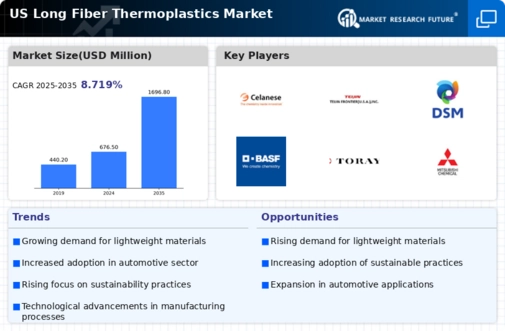The US Long Fiber Thermoplastics Market has been witnessing significant growth due to the increasing demand across various sectors such as automotive, aerospace, and construction. As industries constantly seek lightweight and durable materials, long fiber thermoplastics (LFTs) have emerged as viable solutions, combining the benefits of both polymers and reinforcements. The competitive landscape of this market is characterized by technological advancements, innovative product offerings, and strategic collaborations among players to enhance their market position.
Companies are focusing on research and development to improve the properties of long fiber thermoplastics, which has led to the emergence of high-performance materials that cater to the evolving needs of different applications. Additionally, the market dynamics are influenced by pricing strategies, supply chain management, and regulatory frameworks that govern material usage.Celanese plays a prominent role in the US Long Fiber Thermoplastics Market, leveraging its extensive experience in advanced materials to deliver innovative solutions. The company’s strengths lie in its robust research and development capabilities, which enable it to introduce high-performance LFT products tailored to meet specific industry requirements.
Celanese has established strong relationships with key players in the automotive sector, positioning itself as a trusted partner for LFT solutions. Furthermore, the company's operational excellence and commitment to sustainability initiatives foster a competitive edge, allowing it to adapt swiftly to market demands. Through continuous investment in technology and processes, Celanese strives to enhance its market presence and expand its product offerings within the US.Teijin is another key player in the US Long Fiber Thermoplastics Market, known for its commitment to innovation and quality.
The company offers a range of products that incorporate advanced fiber reinforcement technology, catering to a diverse clientele in industries such as automotive and aerospace. Teijin's strengths lie in its ability to provide customized solutions that enhance the mechanical properties of long fiber thermoplastics, making them suitable for demanding applications. With a strong market presence in the US, Teijin consistently invests in research and development to improve its offerings and maintain a competitive edge. The company has been active in pursuing mergers and acquisitions to expand its technological capabilities and product portfolio, bolstering its position within the market.
By focusing on sustainable practices and integrating eco-friendly materials, Teijin aligns itself with industry trends, further enhancing its reputation and market share in the US Long Fiber Thermoplastics sector.






















Leave a Comment